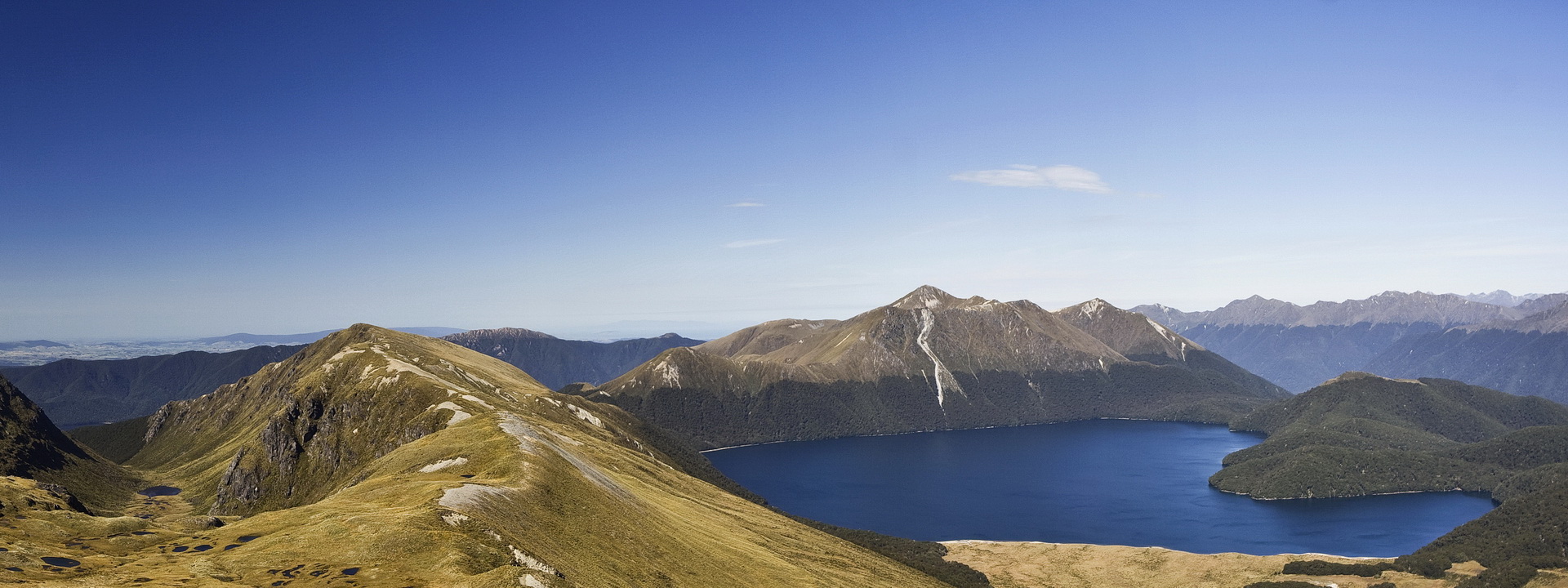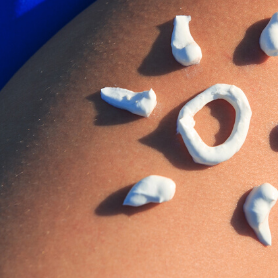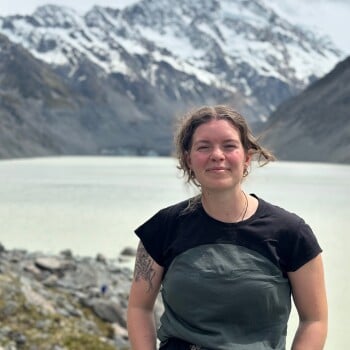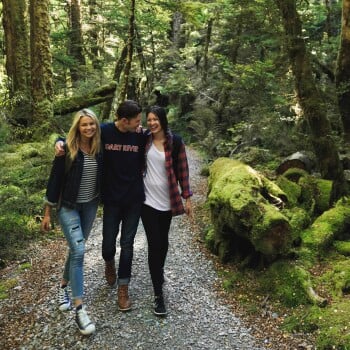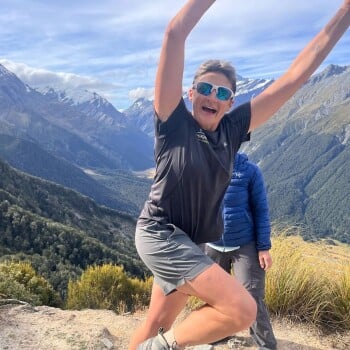- About Us
-
Trips
-
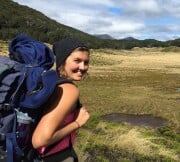 Kiwi-Style Hiking
Kiwi-Style Hiking
-
 Great Walks
Great Walks
-
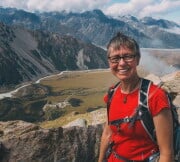 Hiking Tours
Hiking Tours
-
Alpine Hikes
-
Custom Groups
- Huayhuash Trek
- Family Northern Explorer
- Family Southern Explorer
- Lake Waikaremoana Hike
- Women's Custom Tours
- Women's Southern Wilderness
- Coast, Canyons and Mountains
- Coastal Wanderer Custom Tour
- Don't Cross the Ladies
- Secret South Custom Tour
- Tekapo Hike
- West Coast Custom Tour
- World Heritage Custom Tour
-
- Blog
- Shortlist
- About Us
- Trips
- Blog
- Shortlist

Feb 1, 2013
Ryan Holden, of Intrepid Magazine, explore's New Zealand's Secret South with Hiking New Zealand
New Zealand is a hiking paradise. Having never visited this region of the country, a Hiking New Zealand safari provided me with the perfect opportunity to experience the South Island at its best.
Day 1 - Let the adventure begin
Day One of my 10 day ‘SecretSouth’ safari began fittingly in New Zealand’s adventure capital, Queenstown. A crisp early morning saw the group of nine would-be adventurers meet and load up into the Hiking New Zealand van. After a quick introduction by guide Mark O’Connor, we headed to New World to pick up our food supplies for the first few days.
From here it was off to Key Summit, our first hike and the last leg of the world famous Routeburn Track. Before beginning we were treated to the first of many ‘icebreaker’ type games Hiking NZ guides offer to help everyone get to know each other. Without getting into details, we began the hike after five minutes of waving our buttocks and screaming our names, much to the amusement of everyone else in the parking lot.
The Key Summit hike was the perfect introduction to the trip and provided a taste of what Fiordland National Park has to offer. An easy three hour return hike rewarded everyone with spectacular views of the Humboldt and Darran mountains, with the prominent peak of Mt Christina taking centre stage. As he would for the rest of the trip, Mark provided detailed commentary on significant geological features as well as pointing out and describing important plants and wildlife.
Our first night we stayed in Hollyford Camp which I affectionately remember as Sandfly Alley. They will eat you. Founded by David Gunn in 1926 as a base for guiding tourists, the camp certainly has an eccentric air, which is probably a result of its extreme isolation. After the ‘Deliverance’ quotes and theme song had finally run their course we unloaded and set up our tents. Volunteering for cooking duties on this first night were myself and fellow hiker, British film producer Jonathan Challis. A documentary producer for networks like the Discovery Channel, Jonathan was full of interesting little anecdotes. Quizzing him on some of his different adventures he would respond, blasé, “oh (sigh), I chased tornadoes once and flew over a hurricane in a Lear jet this other time.” Jonathan is a perfect example of the diverse personalities one can expect to meet on a Hiking New Zealand safari.
Slaving away in the small but well equipped Hollyford Camp kitchen, battling invading sandflies and choking ourselves and everyone else that dared enter with curry powder, we produced the finest Thai Chicken curry meal of all time. We feasted, then slept.
Day 2 - An early start
Up at 5am, and it’s still dark. Everyone moves quickly and quietly, packing up the gear and cooking breakfast. Today is one of the highlights of the safari - kayaking the famous Milford Sound. With the sun beginning to rise, we whip out of the campground, sandflies in hot pursuit. From the campground to Milford we traveled through the two-kilometre Homer Tunnel which runs straight through the Main Divide, and provides the only road access to the Milford Sound.
The first fact we learned was that Milford Sound isn't a sound - it's a fiord. Measuring 12km long and up to 320m deep the fiord runs inland from the Tasman Sea and is surrounded by sheer cliffs on all sides, rising to well over 1200m. Milford Sound is the wettest place in New Zealand and one of the wettest in the world, with rain for 182 days a year. On this particular day, though, the weather was pristine.
Our kayaking was done through the only Milford-based kayaking company, Rosco’s Milford Sound Sea Kayaks. Taking two-man kayaks we headed out into the fiord on a four hour trip. Guide Jimmy Wright filled everyone in on all the interesting facts on the Milford Sound - and threw in a few harmless fallacies for the tourists. Did you know about the rare "raro-berry," which only grows behind waterfalls and produces orange-flavoured juice? Neither did we, until Jimmy Wright told us.
The kayaking was truly an unforgettable experience. Gliding across the glassy water, I couldn’t imagine any better way to see this natural wonder. From staring at the 160m high Lady Bowen Falls to wildlife like Fur seals or Keas, there is plenty to see. After the kayaking we drove south to our Borland Rd campsite, stopping for a swim and dinner beside Lake Manapouri.
 Day 3 - Fiordland National Park
Day 3 - Fiordland National Park
Day three and we set off from Borland Saddle, headed above the bush-line and traversed across the Hunter Mountain Range. As had become the norm in Fiordland National Park, the views were stunning. Crystal clear alpine tarns (small mountain lakes) left by glaciers thousands of years ago, dot the top of the ranges. Mark also introduced another game - "killer." The game involves one person "killing" members of the group by attaching a clothes peg to their backpacks. At any stage a guess at the killer’s identity can be made, but an incorrect guess results in a “suicide”. In an earlier secret rendezvous, Mark had given me the peg, making me the “killer”. I was determined to remain undetected and over the next seven days would stop at nothing to complete my mission.
After seven hours of hiking under the relentless sun the sight of the Green Lake’s rippling waters was a welcome relief. We quickly disrobed and jumped in the (colder than expected) water. Dinner and a game of Texas Hold’em later and a group of tired adventurers hit the mattresses. This was our first night in a hut and was to be very special. After initially dozing off I awoke to find myself in the middle of a raging battle. The whistling of bombs dropping, the cries of men and women and the deep rumble of exploding shells filled the hut. I found myself lying awake, shell-shocked, listening as each snore was transcended by a greater even more hut-rattling rally. Happily, I was soon deafened and managed some sleep.
Day 4 - Prospect of a hot shower
After hiking back out to Borland Rd on day four we drove south to Curio Bay, situated at the very bottom of New Zealand. Tonight we would be staying in a crib (beach house). Excitement spread through the group at the prospect of a hot shower. The crib had two floors, offering a great view of Curio Bay and plenty of room for everyone to relax. Following a great meal and a hilarious game, in which I learnt that, among other things, both penguins and cats can fly (don't ask), it was off for a peaceful night’s sleep in a cosy bed.
Day 5 - Relaxed hiking
Day five was spent in a relaxing fashion, no backpacks, just a nice leisurely stroll from Surat Bay around to Cannibal Bay, our next campsite. Hooker Sea Lions lazed on the beach and posed for photos. While they looked sluggish, we were careful not to get between them and the ocean as, if threatened, they can move surprisingly fast. Once we had set up a hangi at camp we drove up the road to view a private yellow-eyed penguin colony. From a hide (viewing area) we had an excellent view of the penguins returning after a day at sea. It is intriguing to watch as they swim ashore, stand perfectly still for some time then waddle like old men into the bush. Yellow eyed penguins nest up to 1km inshore. Returning to camp, we were forced to take shelter in an old woolshed while we ate our hangi due to a heavy downpour that would last the entire night.
Day 6 - Search for better weather
Day six we woke to find the weather dreary but at least the rain had taken a break. So we loaded up the van and headed north, in search of better weather and our next hike, Freehold Creek. Tonight we would be camping in a sub-alpine camp just below the bush-line. After a good steady hike up through beech forest we found the campsite to be a nice little spot snug against the creek. The highlight of the site was definitely the toilet. Consisting of a wooden box and a toilet seat, it was the epitome of luxury - with a 360º view of the bush you really feel at one with nature. Mark topped off a great day by treating everyone to his specialty campfire banana dessert after dinner.
Day 7 - Ohau Range
The next morning we were up early for a hike onto Ohau Range. On a good day this vantage point would provide views of the Southern Alps, unfortunately the weather was not kind and thick wet cloud forced us back down the mountain to the van. That afternoon and night was spent relaxing at our second ‘luxury’ stop, a very cosy farm-stay backpackers in Central Otago.
 Day 8 - Highlight Mueller Hut
Day 8 - Highlight Mueller Hut
Day eight featured one of the highlights of the trip, the hike up to Mueller Hut. Mueller Hut is at the top of Mt Ollivier which happens to be the first peak Sir Edmund Hillary ever climbed. Parking in the Mt Cook parking lot we first tackled the steep incline to Sealy Tarns, the halfway point to Mueller Hut. Tiring but rewarding, the steep track soon provided amazing views of Mt Cook (Aoraki) and the Hooker and Mueller glaciers. After a stop for lunch at Sealy Tarns we continued on to Mueller Hut. We were incredibly lucky to have a perfect day for the climb with little cloud, allowing spectacular views. This was my personal highlight of the entire trip and I made a mental note to return in the future. A quick descent and it was off to the nearby Lake Pukaki, our next campsite. Lake Pukaki has a distinctive blue colour, created by finely ground rock particles which are fed into the lake by the Tasman and Hooker glaciers. The lake is also part of the Waitaki hydroelectric scheme and has twice had its level raised to increase storage capacity, submerging "Five Pound Island," which once appeared on the New Zealand five pound note.
Day 9 - Keen for a swim?
The morning of day nine and the group was in for a special treat, the "Pukaki Challenge". This is a special event, unique to Hiking New Zealand. The goal is simple, get up and get wet. We woke early and jumped, - actually, waded hesitantly - into the glacially fed lake...crazy? Yes. Fun? Definitely.
After our 'refreshing' swim we drove north to South Canterbury and into Mt Somers for our last overnight hike. Today we would be 'rock-hopping' up Woolshed Creek and staying in Mt Woolshed Creek Hut. The words 'rock-hopping' tend to imply hopping over water, and not getting wet. Of course, by the the end of the day we were all soaked, some more so than others. I recall a priceless moment when Lu, a Brazilian biologist, decided on "taking the quick way" and ended up holding her pack above her head while the water rose ever higher around her neck. Upon reaching the hut we set about the routine that had become almost second nature by now, building a fire and cooking the food. During the night I again woke to find myself assaulted by my fellow camper's snoring, but this time my mattress and I retreated to safety in another room.
Day 10 - Exploring water caves
Day 10, the final day of the trip and sure enough, it was up at 6am to get wet again. The purpose of this soaking was to explore nearby water caves created by massive boulders that have fallen into the canyon. With 'hard-core' and 'soft-core' options available, the caves were a rush and well worth the drenching. We returned to the hut, had a cup of tea, and then headed down the mountain to the van and civilisation.
Resume
Looking back on this trip I would have to say it is one of the most fulfilling experiences I have ever had. Not only does Hiking New Zealand choose the best "off the beaten track" hikes, it combines this with a great social atmosphere and top guides to provide the best possible experience. I think fellow group member Julian Vaupel summed it up the best: "It was an amazing adventure - it really felt like we were exploring new land, places we wouldn't otherwise see."

